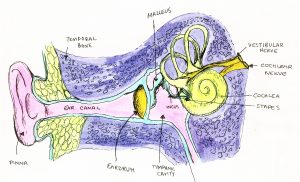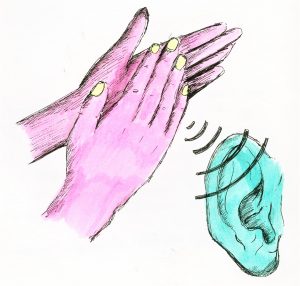
Author: Layal Bou Abdo MSN
Illustration: Angeline Boswell
Ringing, pain, dizziness, difficulty hearing and popping; these two organs at each side of our head can act out sometimes!
Let us explore our auditory system, the process of hearing and identifying sounds.
You perceive sounds without even realizing it most of the time, and your brain is very good at calculating the pitch, the volume and the location of those sounds. There are many steps allowing sounds to be made into something that your brain can understand and sense.
 What is sound?
What is sound?
Close your eye and listen… what do you hear? There are many sounds around us, and those sounds have different names: a noise, a note, music, a tweet, a talk, a horn, etc. Sounds are all around us, and all sounds are made the same way. These sounds start with something that vibrates; this means it juggles around. When something vibrates, it moves back and forth so fast, so sometimes the eyes cannot see it. Everything you see and touch around you everywhere is made of tiny molecules, even the air. When you clap your hands or shout, you push those molecules about. Each one will bump into the other and creates invisible waves. Those waves go spreading through the air.
Experimenting with sounds.
- Put a group of marbles touching together then, roll another marble to crash into them, the group of marbles will move. This is what happens to the air molecule once hit by a sound wave.
- When we ring the bell, the metal that makes up the bell will vibrate. The bell vibration makes the air particles around the bell vibrate, and those particles vibrate the air particle around them and so on! The path of this vibration is called the wave. Do you not have a bell? Try to hit a pot or a metal tin with a wooden spoon. Did you feel the vibrations?
- Place a rubber band around an empty can from top to bottom. Pull the rubber band and let go! Do you hear the sound? Do you see the vibration? Repeat many times… you just made an instrument!
How do we hear those vibrations?
 The ear is made of 3 parts:
The ear is made of 3 parts:
- The outer ear is funnel shape; it flares out and wide.
- The Pinna catch the sounds when they hit it so, they go right inside. The Pinna is made of cartilage.
- The ear canal acts out as an amplifier of the sounds that come into the ear. It makes the sound louder.
- The middle ear
- At the end of the ear canal, the sounds hit the tympanic membrane (or the eardrum). The eardrum starts to bounce it all around. Just like a drum, the surface of the eardrum vibrates. The eardrum’s job is to transform the sound waves into physical vibration. This vibration pass to the tiny bones around the ears called ossicles. Sounding like popsicles.
- The Ossicles; Malleus, Incus and Stapes. When the great drum beats, those bones pass along its message. The eardrum hit the Malleus; the Malleus will hit the Incus who hit the stapes. But if the sound is too quiet, they make it louder. And if the sound is too loud, they soften it up. The ossicles act as a leveller of the sounds.
- The inner ear
- The sound passes on through the Oval Window to the Cochlea (the snail shell shape). The oval window is the door of the Cochlea.
- The Cochlea is full of fluids. When the vibration reaches the oval window, it will vibrate the water inside the cochlea in different motions. Think of the water in the pool. If you push on the side of the pool, you will see waves that move in the water contained in this pool. This is how the sounds get to our Cochlea.
- The organ of Corti is a part of the Cochlea that contains the neurones responsible for sensing sounds. Inside the organ of the Corti, there are liquid and teeny tiny hairs (stereocilia) that move back and forth with the liquid motion. When stapes hits the oval window, the fluid around those hair-like cells moves and makes them dance. This dance changes depending on how the fluid moves. The stereocilia turn the sound waves into electrical signals. Each dance sends different signals to the brain.
The brain
- The neurones, responsible for sensing the sounds, send a message to the auditory nerve and up to the brain.
- Because the brain is wired with different kinds of nerves, the sound message is transferred into various structures in the brain. These structures are responsible for unpacking and sorting the sounds. They are also responsible for recognizing the pitch, frequency and localization of the sounds.
- More simply, the brain interprets the ear electrical signals. Every sound has a unique signal, and the brain matches it with the sound that created it.
What is this funny washing noise in my ear?
Tinnitus is often called “ringing in the ears”. It is a noise in your head that no one else can hear. It may also sound like blowing, washing, roaring, buzzing, hissing, humming, whistling, or sizzling inside your head even when everything is quiet. In fact, you hear it more when there is no outside source of the sounds. The noises heard can be soft or loud. It is caused by the messages between the inner ear and the brain. One possible cause is sometimes by loud music, loud music can damage the hair cells (stereocilia) in the cochlea, and this damage can go away, but it can also be permanent. So you’d better turn down the music.
How do we hear through our bones?
 We learned how we hear when the air hits our eardrums (air-conducted or air-transmitted hearing). But you can also hear sounds through your bones (bone-conducted or bone-transmitted). In some cases, vibrations are heard directly by the inner ear bypassing your eardrums. In fact, this is one of the ways you hear your own voice. This is also how whales hear. And this is what happens when you cover your ears while blocking the air path from the Pinna into the ear canal.
We learned how we hear when the air hits our eardrums (air-conducted or air-transmitted hearing). But you can also hear sounds through your bones (bone-conducted or bone-transmitted). In some cases, vibrations are heard directly by the inner ear bypassing your eardrums. In fact, this is one of the ways you hear your own voice. This is also how whales hear. And this is what happens when you cover your ears while blocking the air path from the Pinna into the ear canal.
The famous composer Beethoven was deaf, and he discovered Bone Conduction. Beethoven found a way to hear the sound of the piano through his jawbone. By attaching a rod to his piano and clenching it in his teeth, he received perception of the sound when vibrations transfer from the piano to his jaw. This has proven that sound could reach our auditory system through another medium besides eardrums, and the other medium is our bones.
This is how bone conduction earphones and devices function. Bone Conduction devices perform the role of your eardrums. These devices decode sound waves and convert them into vibrations received directly by the Cochlea so, the eardrum is never involved. The sound reaches the ears as vibrations through the bones (or skull) and skin.
Why two ears?
Having two ears helps you to determine the direction of the sound. Your brain is smart enough to figure out that if sound hits one ear just before the other and is slightly louder then, this is the direction the sound came from. Having an ear on each side of our head also helps us to hear better.
Why do we get dizzy when we spin around?
The cochlea in the inner ear has 2 more parts: the vestibule and the semicircular canals responsible for the balance. Which means to keep us from falling over.
The 3 semicircular canals are loop-shaped tubes in the inner ear. These loops point in a different direction. One directs to up and down. The second points to the back of your head, and the third points side to side. These loops are filled with liquid and lined with fine hairs, just like in the cochlea, except these hairs pick up body movements instead of sounds. The hairs act like sensors that help you with your balance. When your head moves around, the fluid inside the semicircular canals shifts around and sends signals to your brain. These signals tell your brain which way your head is facing.
Spinning makes you dizzy. The fluid around the hair-like cells in your ears is spinning too. So, when you stop spinning, you are dizzy because the fluid in your inner ear takes a while to stop moving. So, the hairs will send messages to your brain that you are still spinning even when you stop.
The same thing might happen to you when you ride a roller-coaster or take a boat. Everything seems to spin around while, in fact, it is not!
Fill a jar with water and spin it around. You will then see a tornado-like shape when you stop. Similarly, when you spin and stop, the water in your ear continues spinning for a while. And, this is why you feel dizzy.
Ice skaters dancers avoid dizziness when spinning by keeping their eyes locked on a fixed point and then whipping their head around quickly when they cannot twist their neck any further.
Why do my ears pop on a plane or when I am riding up a mountain?
Behind your eardrums, are small air-filled chambers that connect to your throat through tiny tubes; the Eustachian tubes. When the air pressure outside your eardrum changes, air moves through the Eustachian tubes to equalize the pressure inside your head. Consequently, the movement of air creates this popping sensation. Sometimes, if you have a cold or experiencing allergies, your tubes will not equalize quickly enough, causing a louder pop and pain as air presses against the eardrum.
This is for the same reason your ears pop and feel pain when you dive underwater.
To prevent popping your ears during take-off and landing, you could chew gum, move your jaw back and forth, drink some water or ask the doctor about a nasal decongestant if you are experiencing a cold or allergy.
Babies also experience popping of their ears. This is why during take-off and landing, it is better to give babies a pacifier or let them drink from their bottle or breastfeed.
Fun Facts
– Did you know that the Ossicles are the smallest bones in your body? The Malleus, Incus and Stapes look respectively like a hammer, anvil, and stirrup. Some doctors like to call them by how they look like.
– Did you know that Cochlea is a Latin word that means snail shells?
– Did you know that we can hear sounds within a specific frequency range between 20 Hz and 20,000 Hz? Some animals have different ranges. Dolphins, for example, cannot hear sounds as low as we do but can hear high sounds of over 100,000 Hz. Dogs and cats can hear many higher-pitched sounds than we can.
We are confident your kid asks you health (human & animal) questions that genuinely leave you stumped! Leave a comment below, and we are happy to answer “why” in future blogs. Reach out to us on Twitter using the #AskTheLittleMedicalSchool
Copyright © 2021 Little Medical School Ottawa

[…] their current location. Elephants communicate using a secret language using a low-pitch voice that our ears cannot […]
How does the process of sound perception occur in the human auditory system, according to the article?
The process of sound perception involves the conversion of sound waves into electrical signals that are interpreted by the brain, allowing us to hear and make sense of the world around us.
Sound perception in the human auditory system involves three main steps:
1. Sound waves enter the outer ear, where the pinna collects them and the ear canal amplifies them.
2. The vibrations reach the eardrum in the middle ear, causing it to vibrate. These vibrations are transmitted through the ossicles to the cochlea in the inner ear.
3. In the cochlea, vibrations are converted into electrical signals by hair-like cells, which are then sent to the brain via the auditory nerve for interpretation.
This is very informative. It’s helpful to understand the various causes behind ear issues and when to seek medical advice. Thank you for sharing such valuable insights!